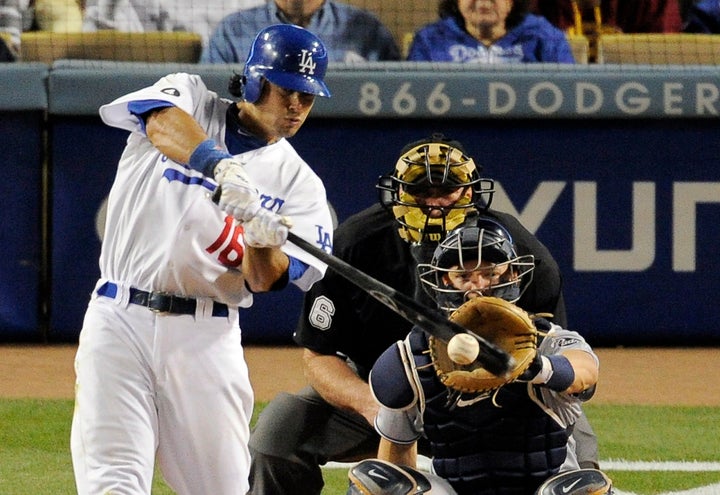
Well, let's see...
Heard notorious sports agent Scott Boras address (and actually charm) a packed ballroom of baseball fans and media about his early playing days. Heard a presentation called Fielder Jones, the Offensive Efficiency Paradox of His Hitless Wonders, and How They Stunned the Cubs in the 1906 World Series By Playing Against Type. Heard a convincing talk by Daryl Grigsby about how opposition to integration hurt the Washington Senators during the 1940s and '50s. Enjoyed an hour-long media panel with Sean Forman, creator of Baseball Reference, Dave Cameron of Fan Graphs, Bill Squadron of Bloomberg Sports and Russ Stanton of the Los Angeles Times about how we willl get our baseball information in 10 years. Browsed through a vendor room that featured a table selling programs and scorecards from the old Pacific Coast League, along with a fabulous collection of small press baseball books I'd never seen, with titles like A History of Double Headers, Death at the Ballpark: A Comprehensive Study of Game-Related Fatalities, and Hard-Luck Harvey Haddix.
And that was all before dinnertime.
Afterwards I took in a superlative FanGraphs panel moderated by author/bloggers Jonah Keri, Rob Neyer, and Carson Cistulli that featured, among others, Rich Lederer of Baseball Analysts, who was largely responsible for Bert Blyleven making the Hall of Fame. The event lasted three hours but was so engrossing it felt like one.
The Society for American Baseball Research (SABR) has been with us since August 10, 1971 (journeyman catcher Sal Fasano's birthday, as we were reminded), and the five-day convention that just wrapped up at the Long Beach Hilton was its 41st. It was the very first one I attended, and being a baseball fanatic since 1964, it's hard to believe it took me this long to get to one.
Still, despite its bent toward deep research and analysis, SABR is not even close to being just a safe harbor for baseball stat heads. The organization sports over 6,000 members, many in their late 50s and 60s, who simply enjoy getting together once a year to deeply talk baseball. There are 35 regional chapters nationwide. There are 23 research and function committees, covering a vast range of topics like Women in Baseball, Latino Baseball, Ballparks, Pictorial History, and even the Deadball Era. There is a Bio Project, an ongoing attempt to research and write comprehensive articles on people who played or managed in the majors, with the current number of bios standing at 1,621.
This year's convention also featured bus trips to Dodger and Angel night games, a daytime tour of features historic baseball sites around L.A.; and an ongoing film festival of 43 baseball-themed features, shorts, cartoons, TV shows and highlight reels. In short, there was something at this convention for every serious baseball fan.
Which made it surprising to not find the halls of the Long Beach Hilton teeming. From what I could see, the challenge for SABR is to increase its membership enough to force an event like this into a giant convention center. According to Aaron Gleeman, blogger for NBC's Hardball Talk who was attending his eighth conference, what started as a "bunch of people accurately researching box scores" in 1971 before stats guru Bill James released his Baseball Abstracts and steered many younger numbers in the group's direction, is now concerned with the advancing age of many of its members. "(SABR Treasurer) F.X. Flinn took me aside once and said 'We gotta get younger. How do we do that?'" related Gleeman.
The division between old school, historically-bent baseball fans and younger, analysis-wired ones has rippled through the baseball world ever since the publication of Michael Lewis' Moneyball, and with the movie version on the horizon (with Brad Pitt playing A's owner Billy Beane), it's only a matter of time before the general baseball public becomes more knowledgeable about the power of on-base percentage, for starters. Many game telecasts now feature and discuss some of the newer statistics, and SABR has had a direct influence on this.
At the SABR convention, this division that has pushed crustier baseball writers like Murray Chass to the brink of irrelevance didn't seem to be on anyone's mind, despite the growing presence of younger, computer-driven members. Sam Miller of the Orange County Register and Baseball Prospectus told me "it's like the World Series of Poker," where old-timers are slowly infiltrated by young hipster card players wearing shades and weird hats. To me, the infiltration seemed far subtler at SABR, and even if there were differences in approaches, there was definitely a pervasive, mutual respect for every facet of the game.
A Friday panel called "The Four Decades of SABR," for instance, featured legendary baseball executive Roland Hemond sitting alongside John Dewan, brilliant founder of STATS, Inc. and Baseball Info Solutions, player agent Dennis Gilbert, author and official MLB historian John Thorn, and ex-first baseman Wes Parker from the 1960s Dodgers. You couldn't find a more diverse set of baseball folk if you tried, but despite Parker's short, dated tirade about the evils of free agency, the panel fascinatingly addressed the many changes baseball has gone through since '71, ("The good old days are now!" proclaimed Hemond) and even had time to field some great questions from the room.*
*Another SABR highlight: Virtually every question I heard from the "public" was reasoned, articulate and worth asking.
SABR Executive Director Marc Appleman was enthused about the upcoming All-Star Fanfest in Phoenix, where SABR would have a presence, the next two conventions in Minneapolis and Philadelphia, and the recent fan-friendly redesign of the SABR Web site. "We are for the passionate baseball fan," he said, also citing SABR Day, an annual event held on the Sunday between the NFL Championship Games and Super Bowl, as an opportunity "for all our chapters to get together" and celebrate what SABR is about.
For my own SABR vacation, I was just glad to be able to actually shake hands and drink beer with many baseball writers I'd "met" on the Internet the past few years. A gaggle of us were in a room hearing research veteran Dave Smith discuss starting rotations when we learned Derek Jeter had just homered in New York for his 3000th hit. Cell phones exploded in tweets, or palm-sized footage of the hit. Larry Granillo of Wezen-Ball, who I was sitting with, had to rush down the hall to time Jeter's trot around the bases. Let's just say it was a surreal experience, as I felt both connected and detached from both events.
I do hope that SABR will be able to reach out to more average intelligent baseball fans, though, because these members-to-be truly don't know what they're missing. John Thorn agrees. "Every American man thinks they know everything about baseball and that they're a great driver," he told me in a quiet moment in the vendor room. Thorn, author of Baseball in the Garden of Eden, the acclaimed account of baseball's origins, as well as an illustrated children's book on the same subject, has been a SABR member for decades, enjoys the conventions for the "camaraderie and research exchange," but still considers them "flat-out fun."
One of Thorn's favorite presentations ever was by Peter Morris, on the origin of the word fan, helping him realize how the game is an endless treasure trove of fascinating facts. "The older I get, the more stupid questions I ask. 'How did we end up with nine innings?' for instance." SABR is for people who "deeply care and can convey these answers. There is very little diffidence here."
I sat through many great talks, most only a half-hour long, but my favorite was a 60-minute retelling of the tumultuous 1965 pennant race between the Dodgers and Giants. Researcher Anthony Giacalone took the Dodger half of the tale while Steve Treder recounted the Giants.' By mixing slides, a smattering of stats and solid, dramatic storytelling, I felt I was there when Juan Marichal smashed Johnny Roseboro on the head with his bat, when Sandy Koufax threw his perfect game in September, and when the Dodgers eeked out the pennant on the final weekend.
If that isn't fun at the old ball convention, I don't know what is.
Jeff Polman is the author of three fictionalized historical baseball replay blogs, The Bragging Rights League being his newest endeavor.
